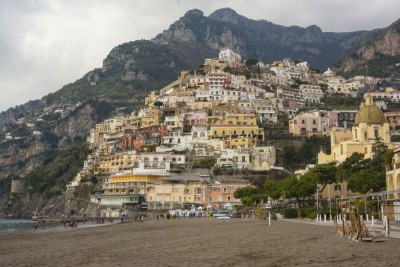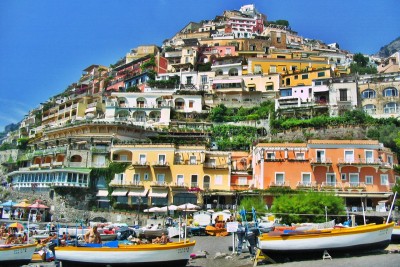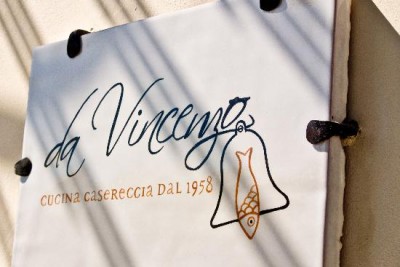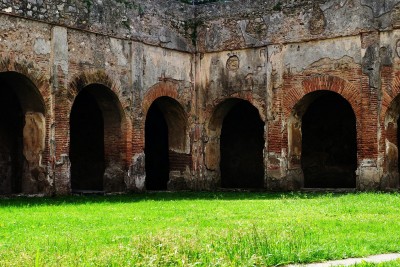Be Aware: Positano Bites Deep
There is only one narrow street, everything else is stairs. So, you either climb or slide




Positano kind of moved in on us and we found ourselves driving down to Naples on our way. To an American, Italian traffic is at first just downright nonsense. It seems hysterical, it follows no rule. You cannot figure what the driver ahead or behind or beside you is going to do next and he usually does it. But there are other hazards besides the driving technique. There are the motor scooters, thousands of them, which buzz at you like mosquitoes… there are gigantic trucks and tanks in which most of Italy’s goods are moved…
To give this madness more color, everyone blows the horn all the time. This deafening, screaming, milling, tire-screeching mess is ordinary Italian traffic…
We squirmed and twisted through Naples, past Pompeii, whirled and flashed into the mountains behind Sorrento. We hummed “Come back to Sorrento” dismally. We did not believe we could get back to Sorrento. Flaming like a meteor we hit the coast, a road, high, high above the blue sea, that hooked and corkscrewed on the edge of nothing, a road carefully designed to be a little narrower than two cars side by side…
In the back seat my wife and I lay clutched in each other’s arms, weeping hysterically… And below us, and it seemed sometimes under us, a thousand feet below lay the blue Tyrrhenian licking its lips for us…
Positano bites deep. It is a dream place that isn’t quite real when you are there and becomes beckoningly real after you have gone. Its houses climb a hill so steep it would be a cliff except that stairs are cut in it. I believe that whereas most house foundations are vertical, in Positano they are horizontal.
The small curving bay of unbelievably blue and green water laps gently on a beach of small pebbles. There is only one narrow street and it does not come down to the water. Everything else is stairs, some of them as steep as ladders. You do not walk to visit a friend, you either climb or slide.
Nearly always when you find a place as beautiful as Positano, your impulse is to conceal it. You think, “If I tell, it will be crowded with tourists and they will ruin it, turn it into a honky-tonk and then the local people will get touristy and there’s your lovely place gone to hell”...
The history of Positano is rich, long and little crazy. But one thing is certain: it has been around a long time. When the Emperor Tiberius moved to Capri because he was detested in Rome, he didn’t trust anyone. He thought people were trying to poison him, and he was probably right. He would not eat bread made with the flour of his part of the country. His galley instead crept down the coast to Positano and got flour from a mill, which still stands against the mountainside. This mill has been improved and kept up, of course, but it still grinds flour for the Positanese.
This little town of Positano has had a remarkable past. As part of the Republic of Amalfi in the ninth, tenth and eleventh centuries, it helped to write the first maritime laws we know in which the rights of sailors were set down. In the tenth century it was one of the most important mercantile cities of the world, rivaling Venice. Having no harbor, its great galleys were pulled bodily up on the beach by the townspeople.
There is a story that on one Holy Saturday when no church bell was allowed to ring in all Christendom, a Positano ship was in trouble from a great storm. The bishop, who was officiating at the altar declared the rule off, rang the bell himself and then joined the population on the beach and in his vestments helped to pull the crippled ship ashore. Like most Italian towns Positano has its miraculous picture. It is a Byzantine representation of the Virgin Mary. Once, long ago, the story goes, the Saracen pirates raided the town and among other things carried away this picture. But they had no sooner put to sea than a vision came to them, which so stunned them, that they returned the picture…
In the sixteenth and seventeenth centuries Positano became very rich. Its ships went everywhere, trading in the Near and Middle East, carrying the spices and precious wood the Western world craved. Then the large and beautiful baroque houses that stand against the mountain were built and decorated with the loot of the world. About a hundred years ago a tragedy came to the town. Steamships began to ply the ocean. Positano could not compete; year-by-year it grew poorer and more desperate. At that time there were about eight thousand citizens.
Between 1860 and 1870 about six thousand of the towns-men emigrated to America and great houses stood vacant and their walls crumbled and the painted designs paled out and the roofs fell in. The population has never got much above two thousand since. If Positano bites deeply into a stranger, it is branded on the Positanese. The bulk of the émigrés went to New York and most of them settled on Columbus Avenue. They made a little Positano of it, they celebrate the same festivals as the mother town, they talk Positano and live Positano…

Positano does not have much of any industry. At night the fishing boats put out with powerful lights on their bows. They fish all night for anchovies and squids, and the bow lights of the boats litter the sea to sight’s edge. But in fishing, Positano has a rival – the little town of Praiano, a few miles down the coast. The rivalry has been so great that a fishing code has been long established. When a school of fish is sighted, the lampara boats run for it. The first boat to reach it puts out its net and makes its circling run.
Meanwhile other boats from the other town have raced for the school. If the first boat completes its circle before the others arrive, the school belongs to it. If not, both the towns share in the catch…
In a few days we became aware of Positano’ s greatest commodity – characters. Maybe they aren’t marketable, but Positano has them above every community I have ever seen. There are the men who have lived in America and have come again to bask in the moral, physical, political and sartorial freedoms, which flourish in their birth town…
A number of writers have gone to Positano to do their work. Some of these are Americans and some are British. Nothing in the little town is designed to disturb your thoughts provided you have a thought…
This is an excerpt of an article published by Harper’s Bazaar in May 1953
Watch a video on Positano








